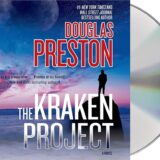 The spotlight last month fell on the special effects wizards who make SF monsters come to life. The crowning glory was the award of the Best Picture Oscar for Argo. This spy drama focuses on the rescue of a group of American embassy workers from Iran, using the cover of a fake SF movie. To create a bogus movie production, the CIA enlist the help of make-up artist John Chambers.
The spotlight last month fell on the special effects wizards who make SF monsters come to life. The crowning glory was the award of the Best Picture Oscar for Argo. This spy drama focuses on the rescue of a group of American embassy workers from Iran, using the cover of a fake SF movie. To create a bogus movie production, the CIA enlist the help of make-up artist John Chambers.
It’s a marriage made in heaven. Like CIA spooks, make-up artists work behind the scenes and achieve success when their results are invisible. Chambers had a long history of success in the business before his role in this covert operation. One early triumph was creating Spock’s ears in Star Trek. He became even more celebrated after his dramatic success with the ape costumes for Planet of the Apes in 1968.
 Even today the quality of those costumes stands up. Take the kindly chimpanzee scientist Zira, played by Kim Hunter. This is one of the strongest female performances in SF movies, along with Sigourney Weaver in Alien or Jennifer Lawrence in The Hunger Games. Yet, Hunter never gets mentioned in the same breath as those other actresses because the costume is so convincing. You forget there is an actress underneath all that fur.
Even today the quality of those costumes stands up. Take the kindly chimpanzee scientist Zira, played by Kim Hunter. This is one of the strongest female performances in SF movies, along with Sigourney Weaver in Alien or Jennifer Lawrence in The Hunger Games. Yet, Hunter never gets mentioned in the same breath as those other actresses because the costume is so convincing. You forget there is an actress underneath all that fur.
 Another master of the animal costume sadly died last month. Stuart Freeborn also developed ape costumes, notably the ones for 2001: A Space Odyssey. His obituary in The Telegraph newspaper describes the painstaking process of creating these outfits:
Another master of the animal costume sadly died last month. Stuart Freeborn also developed ape costumes, notably the ones for 2001: A Space Odyssey. His obituary in The Telegraph newspaper describes the painstaking process of creating these outfits:
It was time-consuming, …, as in many parts of the costume each hair had to be punched into foam latex with a needle.
That technique would serve Freeborn well when he went on to create Chewbacca for Star Wars. In bringing the giant wookie to life, Freeborn developed one of the most convincing fictional aliens ever. Spending equal screen time with real actors, it is almost impossible to tell that there is a man inside that wookie suit. That’s a compliment too to the actor, Peter Mayhew. He didn’t just get the part because he is over two meters tall, but also because he really knows how to move in an unusual way. Playing in a costume is a bit like being a mime artist, and Mayhew never let his discipline slip in the role.
 Sadly, just a few weeks afterwards, Raymond Cusick, another master of sixties special effects passed away. Cusick developed the shell of the Daleks in Doctor Who, creating a design that has remained pretty much the same over the show’s fifty-year history. Whereas other monsters of the time have seen huge revamps of their appearance, such as the cybermen, Cusick’s Daleks retain their original casing.
Sadly, just a few weeks afterwards, Raymond Cusick, another master of sixties special effects passed away. Cusick developed the shell of the Daleks in Doctor Who, creating a design that has remained pretty much the same over the show’s fifty-year history. Whereas other monsters of the time have seen huge revamps of their appearance, such as the cybermen, Cusick’s Daleks retain their original casing.
Cusick developed the Dalek by thinking carefully about the ergonomics of the costume: how the actor would move inside the machine. The results were extraordinary. Back in 1963, he built up a legendary screen alien that triggered a fan frenzy to match the contemporary Beatlemania.
To put his achievement in more context, Cusick also joked that his design department at the time was composed of just him and his assistant, a far cry from the Mac-based nerve centres of today. That’s part of the magic of the work of Chambers, Freeborn and Cusick, that they had to do everything with no recourse to CGI or computer modelling.
In all three cases, their work has truly stood the test of time.











As long as we're talking about Argo, I thought it might be great to give everyone a heads-up that the production drawing for the "real" Argo were done by Jack Kirby, the artist who gave the Fantastic Four and Thor their distinctive looks in the1960s.
https://www.buzzfeed.com/richardrushfield/the-lost…
Thanks for the link, Geoffrey – I had never seen those images before. Kirby's artwork is so cool!
Makes you wish they actually had made the movie, eh? It's very "New Gods" period for Kirby.
You never know – maybe someone is preparing to make the film for real! I have to confess that I had never heard of the real author of Argo before, Roger Zelazny, nor his book that was the basis of the screenplay Lord of Light. It would be nice to hear more about him.
Nice article, Alastair. It's amazing how many layers there are to Argo; it's gonna be one of those films I watch again and again, trying to grasp every last subtextual thread of the thing.
I hadn't heard about Stuart Freeborn's death, until now. (Perhaps I'd assumed he was already dead? Tragic nevertheless.) I'll always think of him as the face of Yoda.
Thanks Alex, I enjoyed your blog too. Argo is a fascinating film and I've been reading about it ever since I saw it too. Did you see the original Wired article that inspired the movie? It's here: https://www.wired.com/magazine/2007/04/feat_cia